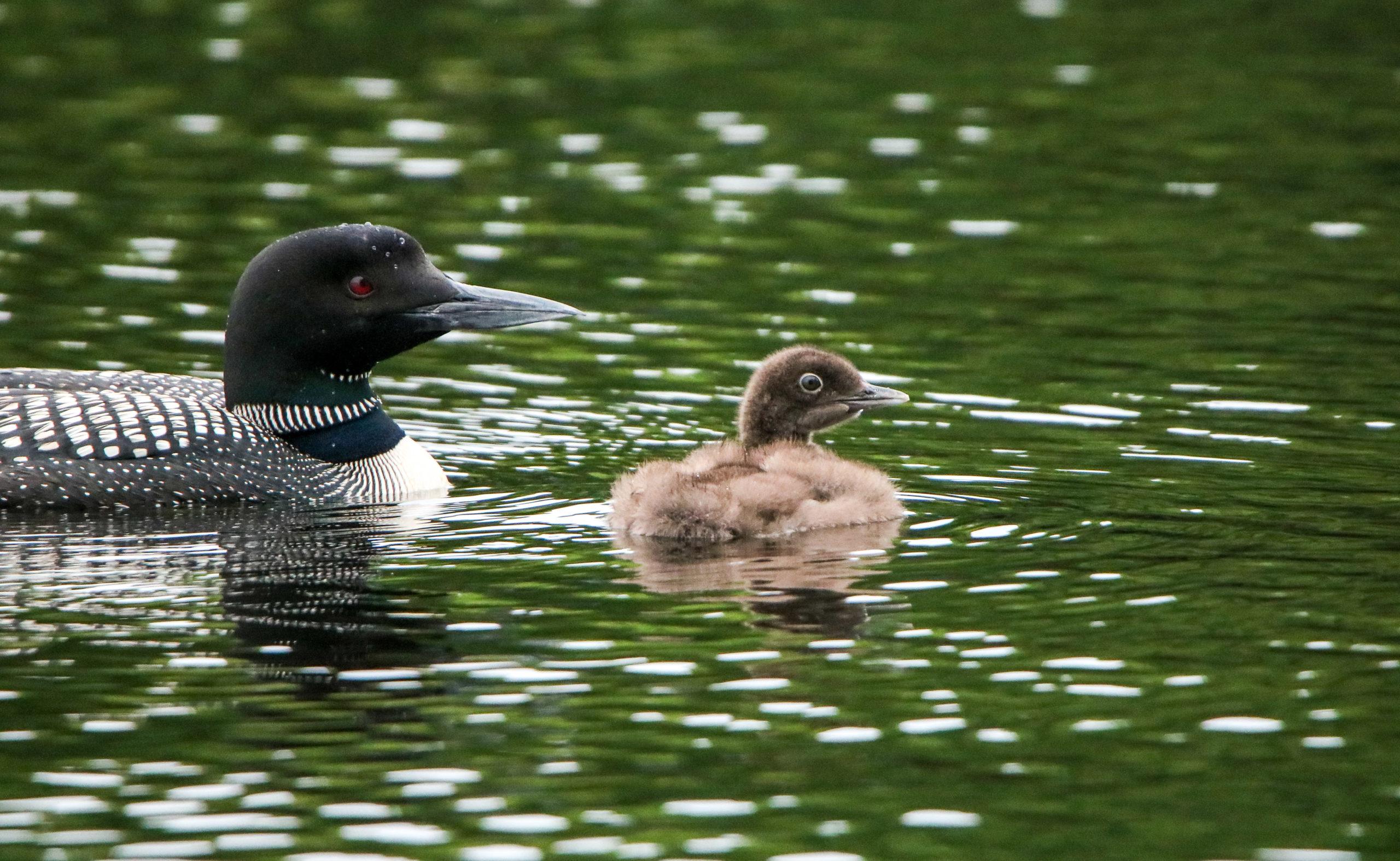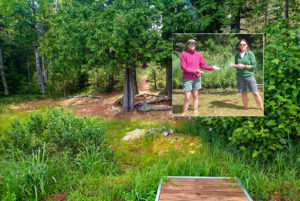In Wisconsin, Michigan and Minnesota, loons typically begin to arrive on their nest lakes around mid-to-late April. The first order of business is to establish a territory then attract a mate. This is done during the last weeks of April and early in May – then nesting begins. Most loons in Wisconsin are nesting by mid-May, which means eggs begin to hatch one month later in early to mid June. Some pairs that begin nesting later, or who lose their first nest and try a second time, will have eggs hatching into early July.
The first four weeks are the most critical in a young loon’s life. This is the time when they are covered in downy feathers and are unable to maintain their internal body temperature. It is when the chicks are completely dependent upon their parents, so adults spend most of their time catching fish and feeding the chicks. This is also when chicks are learning to dive, so the typical way a loon avoids danger, diving, is not an option for them. Once the young loons reach four weeks of age, they have molted into their first set of feathers and can maintain a regular body temperature, and they are able to dive and are catching some of their own food. Once the young become self-sufficient, adults begin spending less time with them, as they prepare to leave on their fall migration. The young loons stay behind until almost ice-up, feeding and gaining strength to make the southward flight themselves.
Therefore, the most important time for loons, in terms of ensuring successful reproduction, is from May through mid-to-late July. This is when adults are sensitive to intrusions at the nest site, and, later, when young are most dependent on the parents. Any sustained disturbance during the nesting season or during the early stages of chick-rearing can be detrimental to a loon pair’s nest success for that year. Because loons lay only two eggs per nest, and usually only have one or two (if the first nest is lost) opportunities to lay eggs each season, even one year of disturbance can have negative effects on an area’s loon population over the long-term.
So what can we do? All of this does NOT mean that we cannot use a lake during the summer. It simply means that we have to be mindful of the fact that we share the lake with others – people and wildlife. Here are some things we can do to help loons while enjoying the lake ourselves:
- Observe loons from a distance with binoculars or a spotting scope rather than trying to get close to them. Stay 200 feet away from loons on nest or on the water whenever possible.
- Give islands and marshy areas of a lake a wide berth to avoid disturbing loons on nests.
- Post Loon Alert signs at public boat launches to let visitors know that loons use the lake and that the people who live there care enough to protect them.
- Protect or restore important loon nesting and chick rearing areas on a lake.
- Use alternatives to lead fishing tackle made from materials such as bismuth and steel. It only takes one lead sinker or jig to poison a loon.
Loons can be tolerant of human recreation and even raise young successfully on lakes that have regular recreational use. But people using the lake need to be mindful of the loon’s presence and have the courtesy to give them some space. If we do this, we will be fortunate enough to have loons return to our lakes year after year, and we can be sure that the loon’s call we hear floating on the morning mists or the evening air is one of life and harmony and not a sounding of the alarms that something is wrong.
Help Protect Loons
Watch loons from at least 200 feet away. Get a powerful lens for your camera, use binoculars or a spotting scope for viewing, and never explore a loon nest site.
Close encounters can be deadly for swimming and nesting loons.
Use non-lead fishing sinkers and jigs. Ingesting one lead sinker or jig will kill a loon.
Avoid exploring or camping on islands before July 15th of each year. Loons prefer islands for nesting. Disturbance can cause a loon to abandon its nest.
Protect native vegetation on all shores. Loons nest on natural shorelines and use the natural materials to build their nests.
Conserve electricity. Mercury emissions contaminate lakes and loon food.
Dispose of household garbage at a collection site. Garbage draws raccoons, foxes, gulls, and eagles, which prey on loon eggs. Trash can also ensnare wildlife, including loons.
Be an ethical angler. Never fish or cast near loon nests or swimming loons, properly dispose of extra bait and trash, and pick up monofilament line.
Keep dogs and cats away from loons and nests. Pets disturb nesting loons and can destroy loon eggs.
Use only phosphorus-free fertilizers on shorelands, and only if needed. Fertilizer that runs off into lakes increases aquatic plant growth, making it difficult for loons to swim and find food.
Report any unusual loon activity or harassment of loons to your lake’s Loon Ranger. Find out who is the official Loon Ranger on your lake and report your observations to him or her.
Monitor water quality or invasive species. Check with your lake association for ways that you can help.
Be a responsible boater. Never chase loons or run motorboats or personal watercraft over areas where loons have been seen. Loons and loon chicks have died from being hit by boats and propellers.
Practice and teach wildlife stewardship… always!
This article was prepared by LoonWatch – Northland College
Discover more from Vilas County Lakes & Rivers Association
Subscribe to get the latest posts sent to your email.




